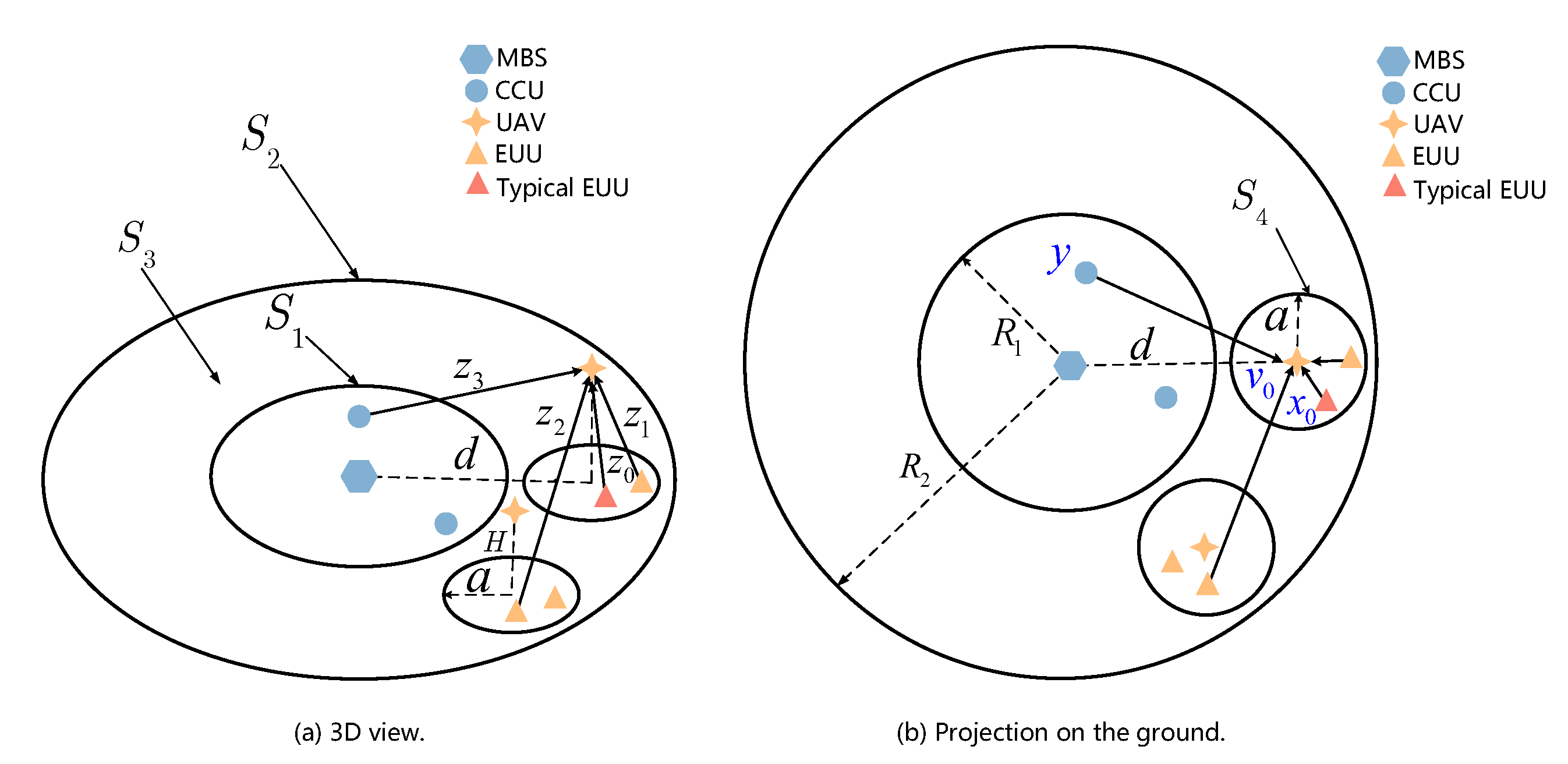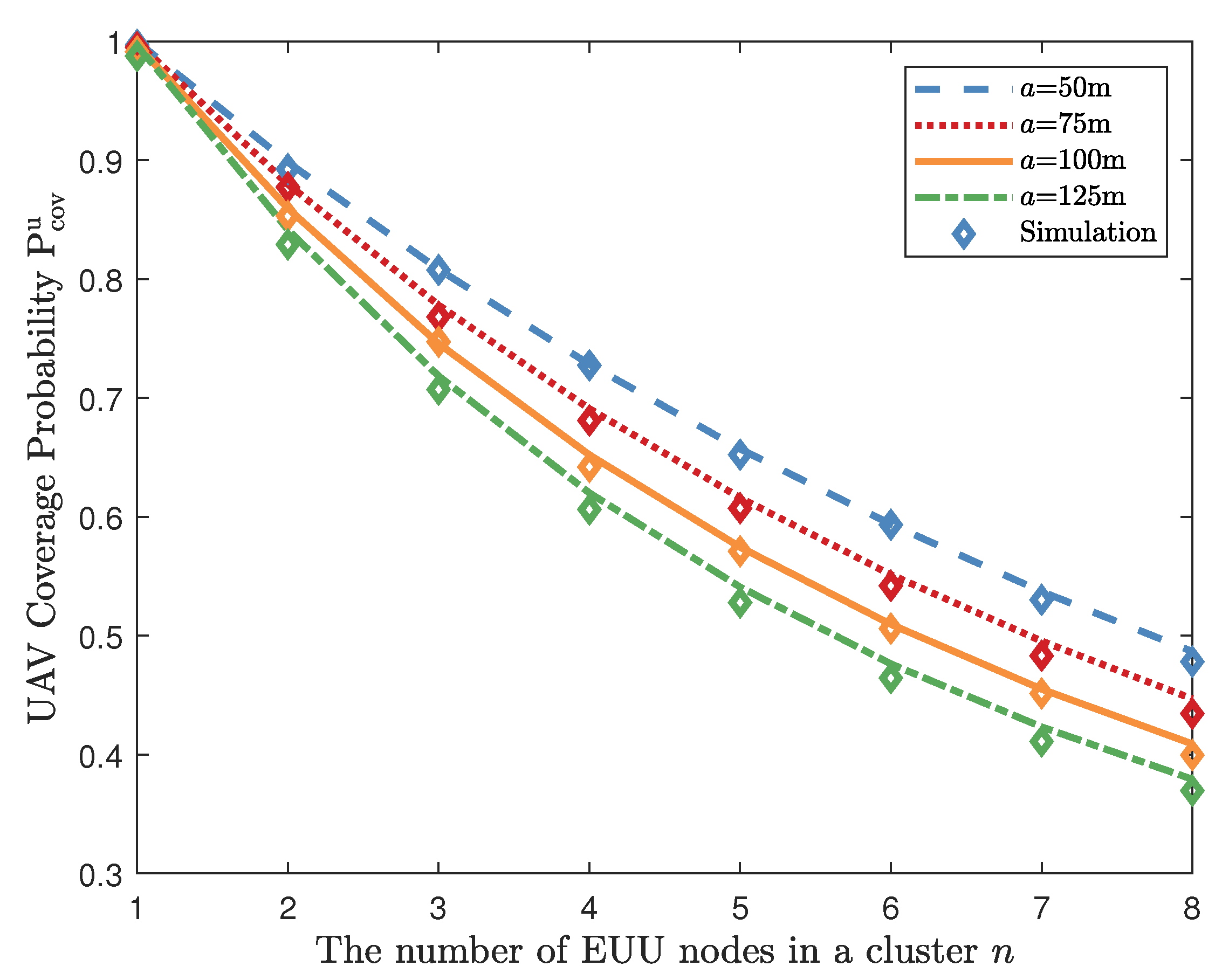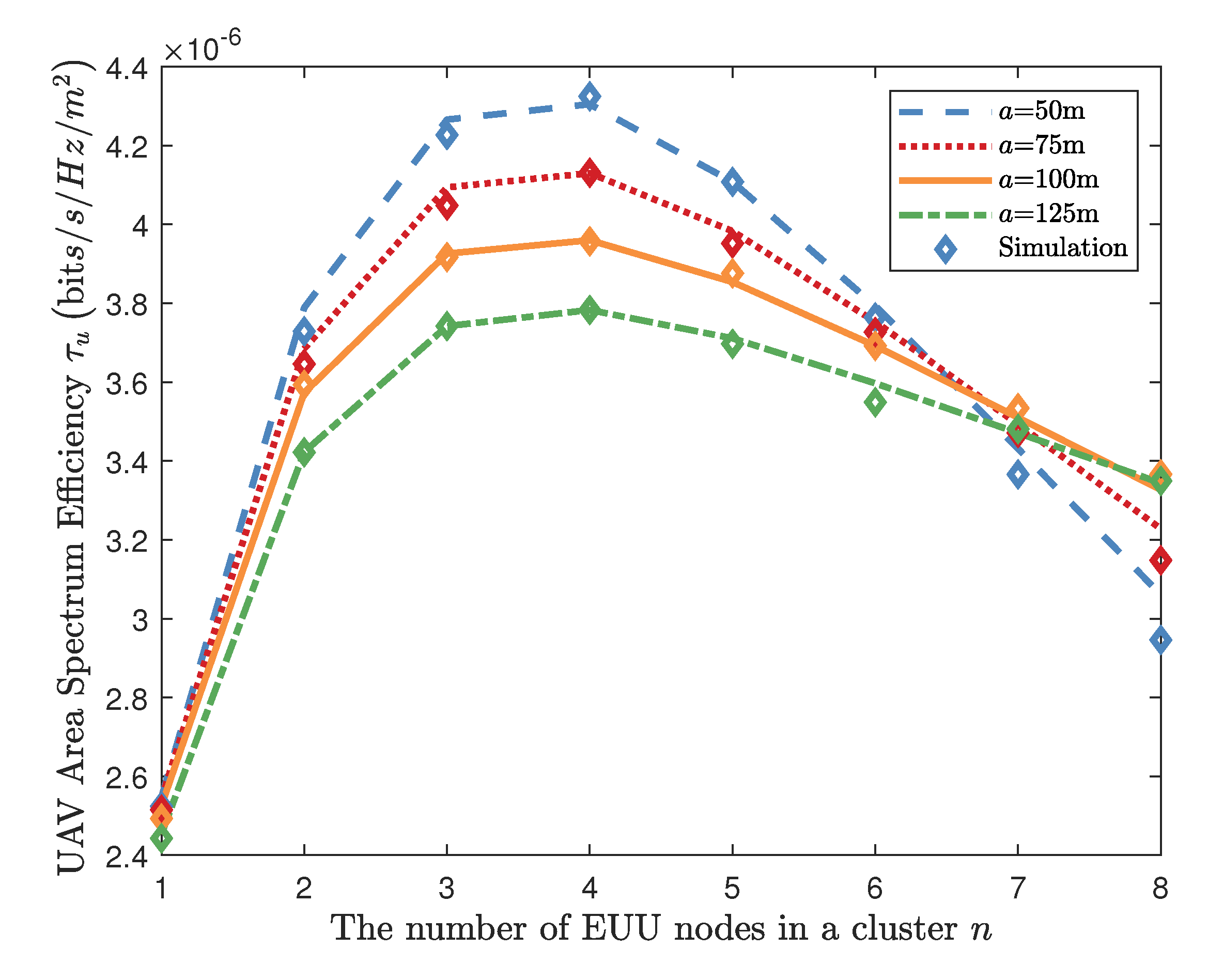Modeling and Performance Analysis in UAV-Assisted Cellular Networks with Clustered Edge Users
Abstract
:1. Introduction
1.1. Related Work
1.2. Summary and Organization
- By using the tools of stochastic geometry, a novel topology of the uplink UAV-assisted network consisting of MBS, large-scale UAVs, and users is proposed based on the Poisson hole process (PHP) model [33,34]. To improve the communication quality of edge users, we assume that UAVs are deployed on the cell edge to serve edge UAV users (EUUs). Specifically, the locations of center cellular users (CCUs) and UAVs are modeled as independent HPPPs, and EUUs are expected to cluster around each UAV. Hence, different from many previous studies where the locations of users and UAVs are uncorrelated, modeling the locations of EUUs as PCP is more suitable and realistic. Moreover, we combine the HPPP with PCP to provide an appropriate model in some complex scenarios.
- In the practical deployment of large-scale UAVs, there is strong interference caused by users and UAVs in the overlapping coverage. To enhance the coverage rate of UAVs, we proposed the PCDC strategy to model the distributions of UAVs and EUUs. Specially, there are distance constraints between UAVs, and the coverage area of each UAV does not overlap under this strategy. Moreover, using the tools of stochastic geometry, the interference among EUUs, CCUs, UAVs, and MBS is analyzed, respectively.
- The coverage probability and area spectrum efficiency are analyzed from the perspective of the UAV and MBS, respectively. The energy efficiency of the entire network is also investigated. Numerical results have shown that system performance can be further intensified by adjusting the transmit power of EUUs or CCUs, the number of EUUs in each cluster, the radius of the cluster, and other design settings. In particular, there exists an optimal value for the radius of the cluster to maximize the area’s spectrum efficiency.
2. System Model
2.1. The UAV-Assisted Network Model
2.2. Air-Ground Channel Model
2.3. Propagation Model
2.3.1. Intra-Cluster Interference
2.3.2. Inter-Cluster Interference
2.3.3. Other Interference
2.3.4. Interference from EUUs
2.4. Performance Metric
3. Interference Analysis
3.1. Laplace Transforms for Interference at UAV
3.1.1. Intra-Cluster Interference
3.1.2. Inter-Cluster Interference
3.1.3. Other Interference
3.2. Lapalace Transforms for Interferences at MBS
Interference from Edge Users
4. Performance Analysis
4.1. Coverage Probability Analysis
4.2. Area Spectral Efficiency
4.3. Energy Efficiency
5. Numerical Results
6. Conclusions
Author Contributions
Funding
Data Availability Statement
Conflicts of Interest
References
- Bithas, P.S.; Nikolaidis, V.; Kanatas, A.G.; Karagiannidis, G.K. UAV-to-Ground Communications: Channel Modeling and UAV Selection. IEEE Wirel. Commun. 2020, 68, 5135–5144. [Google Scholar] [CrossRef]
- Akyildiz, I.F.; Kak, A.; Nie, S. 6G and Beyond: The Future of Wireless Communications Systems. IEEE Access 2020, 8, 133995–134030. [Google Scholar] [CrossRef]
- Andrews, J.G.; Buzzi, S.; Choi, W.; Hanly, S.V.; Lozano, A.; Soong, A.C.; Zhang, J.C. What Will 5G Be? IEEE J. Sel. Areas Commun. 2014, 32, 1065–1082. [Google Scholar] [CrossRef]
- Cui, Z.; Briso-Rodríguez, C.; Guan, K.; Güvenç, İ.; Zhong, Z. Wideband Air-to-Ground Channel Characterization for Multiple Propagation Environments. IEEE Antennas Wirel. Propag. Lett. 2020, 19, 1634–1638. [Google Scholar] [CrossRef]
- Zhao, N.; Lu, W.; Sheng, M.; Chen, Y.; Tang, J. UAV-Assisted Emergency Networks in Disasters. IEEE Wirel. Commun. 2019, 26, 45–51. [Google Scholar] [CrossRef] [Green Version]
- Gupta, L.; Jain, R.; Vaszkun, G. Survey of Important Issues in UAV Communication Networks. IEEE Commun. Surv. Tutor. 2016, 18, 1123–1152. [Google Scholar] [CrossRef] [Green Version]
- Zhou, X.; Durrani, S.; Guo, J.; Yanikomeroglu, H. Underlay Drone Cell for Temporary Events: Impact of Drone Height and Aerial Channel Environments. IEEE Internet Things J. 2019, 6, 1704–1718. [Google Scholar] [CrossRef] [Green Version]
- Kuru, K.; Ansell, D.; Khan, W.; Yetgin, H. Analysis and Optimization of Unmanned Aerial Vehicle Swarms in Logistics: An Intelligent Delivery Platform. IEEE Access 2019, 7, 15804–15831. [Google Scholar] [CrossRef]
- Lee, S.; Har, D.; Kum, D. Drone-Assisted Disaster Management: Finding Victims via Infrared Camera and Lidar Sensor Fusion. In Proceedings of the 2016 3rd Asia-Pacific World Congress on Computer Science and Engineering (APWC on CSE), Nadi, Fiji, 5–6 December 2016. [Google Scholar]
- Cui, Z.; Guan, K.; Zhang, J.; Zhong, Z. SNR Coverage Probability Analysis of RIS-Aided Communication Systems. IEEE Trans. Veh. Technol. 2021, 70, 3914–3919. [Google Scholar] [CrossRef]
- Cheng, J.; Guan, K.; Quitin, F. Direction-of-Arrival Estimation With Virtual Antenna Array: Observability Analysis, Local Oscillator Frequency Offset Compensation, and Experimental Results. IEEE Trans. Instrum. Meas. 2021, 70, 1–13. [Google Scholar] [CrossRef]
- Guo, H.; Liu, J. UAV-Enhanced Intelligent Offloading for Internet of Things at the Edge. IEEE Trans. Ind. Inform. 2020, 16, 2737–2746. [Google Scholar] [CrossRef]
- Zhou, Y.; Rao, B.; Wang, W. UAV Swarm Intelligence: Recent Advances and Future Trends. IEEE Access 2020, 8, 183856–183878. [Google Scholar] [CrossRef]
- Islambouli, R.; Sharafeddine, S. Autonomous 3D Deployment of Aerial Base Stations in Wireless Networks with User Mobility. In Proceedings of the 2019 IEEE Symposium on Computers and Communications (ISCC), Barcelona, Spain, 29 June–3 July 2019. [Google Scholar]
- Yaliniz, R.; El-Keyi, A.; Yanikomeroglu, H. Efficient 3-D Placement of an Aerial Base Station in Next Generation Cellular Networks. In Proceedings of the 2016 IEEE International Conference on Communications (ICC), Kuala Lumpur, Malaysia, 22–27 May 2016. [Google Scholar]
- Zhang, S.; Zeng, Y.; Zhang, R. Cellular-Enabled UAV Communication: A Connectivity-Constrained Trajectory Optimization Perspective. IEEE Trans. Wirel. Commun. 2019, 67, 2580–2604. [Google Scholar] [CrossRef] [Green Version]
- Azari, M.M.; Rosas, F.; Chiumento, A.; Pollin, S. Reshaping Cellular Networks for the Sky: Major Factors and Feasibility. In Proceedings of the 2018 IEEE International Conference on Communications (ICC), Kansas City, MO, USA, 20–24 May 2018. [Google Scholar]
- Na, Z.; Liu, Y.; Shi, J.; Liu, C.; Gao, Z. UAV-Supported Clustered NOMA for 6G-Enabled Internet of Things: Trajectory Planning and Resource Allocation. IEEE Internet Things J. 2021, 8, 15041–15048. [Google Scholar] [CrossRef]
- Rohde, S.; Wietfeld, C. Interference Aware Positioning of Aerial Relays for Cell Overload and Outage Compensation. In Proceedings of the 2012 IEEE Vehicular Technology Conference (VTC Fall), Quebec City, QC, Canada, 3–6 September 2012. [Google Scholar]
- Hayajneh, A.M.; Zaidi, S.A.R.; McLernon, D.C.; Ghogho, M. Drone Empowered Small Cellular Disaster Recovery Networks for Resilient Smart Cities. In Proceedings of the 2016 IEEE International Conference on Sensing, Communication and Networking (SECON Workshops), London, UK, 27 June 2016. [Google Scholar]
- Ji, L.; Chen, J.; Feng, Z. Spectrum allocation and performance analysis for backhauling of UAV assisted cellular network. China Commun. 2019, 16, 83–92. [Google Scholar] [CrossRef]
- Lakew, D.S.; Masood, A.; Cho, S. 3D UAV Placement and Trajectory Optimization in UAV Assisted Wireless Networks. In Proceedings of the 2020 International Conference on Information Networking (ICOIN), Barcelona, Spain, 7–10 January 2020. [Google Scholar]
- Yang, X.; Li, Z.; Ge, X. Deployment Optimization of Multiple UAVs in Multi-UAV Assisted Cellular Networks. In Proceedings of the 2019 11th International Conference on Wireless Communications and Signal Processing (WCSP), Xi’an, China, 23–25 October 2019. [Google Scholar]
- Shukla, S.; Thakur, R.; Agarwal, S. Particle Swarm Optimization Algorithms for Altitude and Transmit Power Adjustments in UAV-Assisted Cellular Networks. In Proceedings of the 2021 IEEE 93rd Vehicular Technology Conference (VTC2021-Spring), Helsinki, Finland, 25–28 April 2021. [Google Scholar]
- Khan, T.A.; Orlik, P.V.; Kim, K.J.; Heath, R.W.; Sawa, K. A Stochastic Geometry Analysis of Large-Scale Cooperative Wireless Networks Powered by Energy Harvesting. IEEE Trans. Wirel. Commun. 2017, 65, 3343–3358. [Google Scholar] [CrossRef]
- Chetlur Ravi, V.V.; Dhillon, H.S. Downlink coverage probability in a finite network of unmanned aerial vehicle (UAV) base stations. In Proceedings of the 2016 IEEE 17th International Workshop on Signal Processing Advances in Wireless Communications (SPAWC), Edinburgh, UK, 3–6 July 2016. [Google Scholar]
- Armeniakos, C.K.; Bithas, P.S.; Kanatas, A.G. SIR Analysis in 3D UAV Networks: A Stochastic Geometry Approach. IEEE Access 2020, 8, 204963–204973. [Google Scholar] [CrossRef]
- Qi, L.; Yan, S.; Peng, M. Modeling and Performance Analysis in UAV Assisted Ultra Dense Networks. In Proceedings of the 2018 IEEE International Conference on Communications Workshops (ICC Workshops), Kansas City, MO, USA, 20–24 May 2018. [Google Scholar]
- Chu, E.; Kim, J.M.; Jung, B.C. Interference Analysis of Directional UAV Networks: A Stochastic Geometry Approach. In Proceedings of the 2019 Eleventh International Conference on Ubiquitous and Future Networks (ICUFN), Zagreb, Croatia, 2–5 July 2019. [Google Scholar]
- Zhou, L.; Yang, Z.; Zhou, S.; Zhang, W. Coverage Probability Analysis of UAV Cellular Networks in Urban Environments. In Proceedings of the 2018 IEEE International Conference on Communications Workshops (ICC Workshops), Kansas City, MO, USA, 20–24 May 2018. [Google Scholar]
- Turgut, E.; Gursoy, M.C. Downlink Analysis in Unmanned Aerial Vehicle (UAV) Assisted Cellular Networks with Clustered Users. IEEE Access 2018, 6, 36313–36324. [Google Scholar] [CrossRef]
- Yi, W.; Liu, Y.; Deng, Y.; Nallanathan, A. Clustered UAV Networks With Millimeter Wave Communications: A Stochastic Geometry View. IEEE Trans. Commun. 2020, 68, 4342–4357. [Google Scholar] [CrossRef]
- Hernandez-Aquino, R.; Zaidi, S.A.R.; McLernon, D.; Ghogho, M. Modelling and performance evaluation of non-uniform two-tier cellular networks through Stienen model. In Proceedings of the 2016 IEEE International Conference on Communications (ICC), Kuala Lumpur, Malaysia, 22–27 May 2016. [Google Scholar]
- Guo, X.; Zhang, C.; Yu, F.; Chen, H. Coverage Analysis for UAV-Assisted MmWave Cellular Networks Using Poisson Hole Process. IEEE Trans. Veh. Technol. 2021. [Google Scholar] [CrossRef]
- Guo, J.; Durrani, S.; Zhou, X. Outage Probability in Arbitrarily-Shaped Finite Wireless Networks. IEEE Trans. Wirel. Commun. 2014, 62, 699–712. [Google Scholar] [CrossRef]
- Khalid, Z.; Durrani, S. Distance Distributions in Regular Polygons. IEEE Trans. Veh. Technol. 2013, 62, 2363–2368. [Google Scholar] [CrossRef] [Green Version]







| System Parameter | Value |
|---|---|
| The coverage area radius of cellular network | 800 m |
| The coverage area radius of the MBS | 500 m |
| The height of UAVs H | 50 m |
| The density of UAVs | nodes/m |
| The density of CCUs | nodes/m |
| Path loss exponent | 4 |
| The power of AWGN | −110 dBm |
Publisher’s Note: MDPI stays neutral with regard to jurisdictional claims in published maps and institutional affiliations. |
© 2022 by the authors. Licensee MDPI, Basel, Switzerland. This article is an open access article distributed under the terms and conditions of the Creative Commons Attribution (CC BY) license (https://creativecommons.org/licenses/by/4.0/).
Share and Cite
Yao, Y.; Wu, Y.; Zhu, Z.; Qin, X.; Yue, X. Modeling and Performance Analysis in UAV-Assisted Cellular Networks with Clustered Edge Users. Electronics 2022, 11, 828. https://doi.org/10.3390/electronics11050828
Yao Y, Wu Y, Zhu Z, Qin X, Yue X. Modeling and Performance Analysis in UAV-Assisted Cellular Networks with Clustered Edge Users. Electronics. 2022; 11(5):828. https://doi.org/10.3390/electronics11050828
Chicago/Turabian StyleYao, Yuanyuan, Yunga Wu, Zhengyu Zhu, Xiaoqi Qin, and Xinwei Yue. 2022. "Modeling and Performance Analysis in UAV-Assisted Cellular Networks with Clustered Edge Users" Electronics 11, no. 5: 828. https://doi.org/10.3390/electronics11050828
APA StyleYao, Y., Wu, Y., Zhu, Z., Qin, X., & Yue, X. (2022). Modeling and Performance Analysis in UAV-Assisted Cellular Networks with Clustered Edge Users. Electronics, 11(5), 828. https://doi.org/10.3390/electronics11050828







